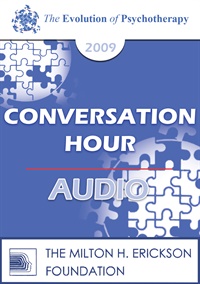EP09 Conversation Hour 05 – Salvador Minuchin, MD
- Average Rating:
- Not yet rated
- Topic Areas:
- Conversation Hours | Psychotherapy | Family Therapy | Supervision | Systems Theory | Therapist Development
- Categories:
- Evolution of Psychotherapy | Evolution of Psychotherapy 2009 | Pioneers in Couples and Family Therapy
- Faculty:
- Salvador Minuchin, MD
- Duration:
- 1 Hour 06 Minutes
- Format:
- Audio Only
- Original Program Date:
- Dec 11, 2009
- License:
- Never Expires.
Description
Description: Minuchin outlines a culturally attuned assessment model that reframes pathology and engages family members as agents of change. He stresses the need to adapt language and technique across diverse systems, especially in cases involving single parents or suicidality. The talk critiques individual therapy’s limits and calls for a more systemic, inclusive approach to healing.
Educational Objectives:
- To learn the philosophies of various practitioners and theorists.
*Sessions may be edited for content and to preserve confidentiality*
Credits
Handouts
| Timestamped Transcript (721.4 KB) | 16 Pages | Available after Purchase |
| Ericksonian Learning Snapshot (242.7 KB) | 2 Pages | Available after Purchase |
Faculty

Salvador Minuchin, MD Related Seminars and Products
Salvador Minuchin, MD, developed Structural Family Therapy, which addresses problems within a family by charting the relationships between family members, or between subsets of family. He was Director of the Philadelphia Child Guidance Clinic. Although it was minimally staffed when he began, under his tutelage the Clinic grew to become one of the most modeled and respected child guidance facilities in the world. In 1981, Minuchin began his own family therapy center in New York. After his retirement in 1996, the center was renamed the Minuchin Center. Dr. Minuchin is the author of many notable books, including many classics. His latest is Mastering Family Therapy: Journeys of Growth and Transformation. In 2007, a survey of 2,600 practitioners named Minuchin as one of the ten most influential therapists of the past quarter-century.


